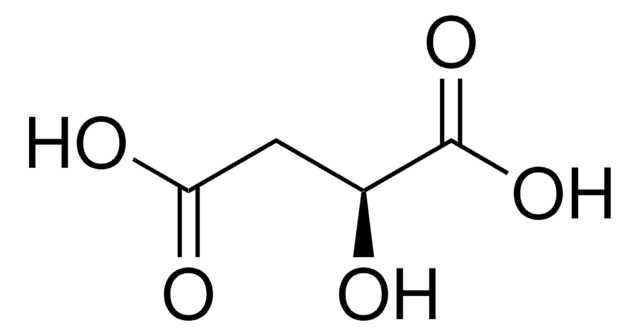Wichtige Dokumente
G8415
L-Glutaminsäure
98.5-100.5%, suitable for cell culture, non-animal source, meets EP testing specifications
Synonym(e):
(S)-2-Amino-glutarsäure, Glu
About This Item
Empfohlene Produkte
Produktbezeichnung
L-Glutaminsäure, from non-animal source, meets EP testing specifications, suitable for cell culture, 98.5-100.5%
Biologische Quelle
non-animal source
Qualitätsniveau
Agentur
meets EP testing specifications
Assay
98.5-100.5%
Form
powder
Methode(n)
cell culture | mammalian: suitable
Verunreinigungen
endotoxin, tested
Farbe
white
mp (Schmelzpunkt)
205 °C (dec.) (lit.)
Löslichkeit
1 M HCl: 100 mg/mL
Dichte
1.54 g/cm3 at 20 °C
Anionenspuren
chloride (Cl-): ≤200 ppm
sulfate (SO42-): ≤200 ppm
Kationenspuren
As: ≤1 ppm, passes test
Fe: ≤10 ppm, passes test
NH4+: ≤200 ppm, passes test
Anwendung(en)
pharmaceutical (small molecule)
SMILES String
N[C@@H](CCC(O)=O)C(O)=O
InChI
1S/C5H9NO4/c6-3(5(9)10)1-2-4(7)8/h3H,1-2,6H2,(H,7,8)(H,9,10)/t3-/m0/s1
InChIKey
WHUUTDBJXJRKMK-VKHMYHEASA-N
Angaben zum Gen
human ... CCR2(1231) , GRIA1(2890) , GRIA2(2891) , GRIA4(2893) , GRIK1(2897) , GRIK2(2898) , GRIK3(2899) , GRIK5(2901) , GRIN2B(2904) , GRM2(2912) , SLC1A1(6505) , SLC1A2(6506)
rat ... Gria1(50592) , Grik1(29559) , Grik2(54257) , Grik4(24406) , Grin2a(24409) , Grm1(24414) , Grm2(24415) , Grm3(24416) , Grm4(24417) , Grm5(24418) , Grm6(24419) , Grm7(81672) , Slc1a2(29482)
Suchen Sie nach ähnlichen Produkten? Aufrufen Leitfaden zum Produktvergleich
Anwendung
Biochem./physiol. Wirkung
Anwendung
Lagerklassenschlüssel
11 - Combustible Solids
WGK
WGK 1
Flammpunkt (°F)
Not applicable
Flammpunkt (°C)
Not applicable
Persönliche Schutzausrüstung
Eyeshields, Gloves, type N95 (US)
Hier finden Sie alle aktuellen Versionen:
Besitzen Sie dieses Produkt bereits?
In der Dokumentenbibliothek finden Sie die Dokumentation zu den Produkten, die Sie kürzlich erworben haben.
Kunden haben sich ebenfalls angesehen
guidance
Artikel
Sigma-Aldrich presents an article about how proliferatively active cells require both a source of carbon and of nitrogen for the synthesis of macromolecules. Although a large proportion of tumor cells utilize aerobic glycolysis and shunt metabolites away from mitochondrial oxidative phosphorylation, many tumor cells exhibit increased mitochondrial activity.
Chromatograms
application for HPLCUnser Team von Wissenschaftlern verfügt über Erfahrung in allen Forschungsbereichen einschließlich Life Science, Materialwissenschaften, chemischer Synthese, Chromatographie, Analytik und vielen mehr..
Setzen Sie sich mit dem technischen Dienst in Verbindung.










